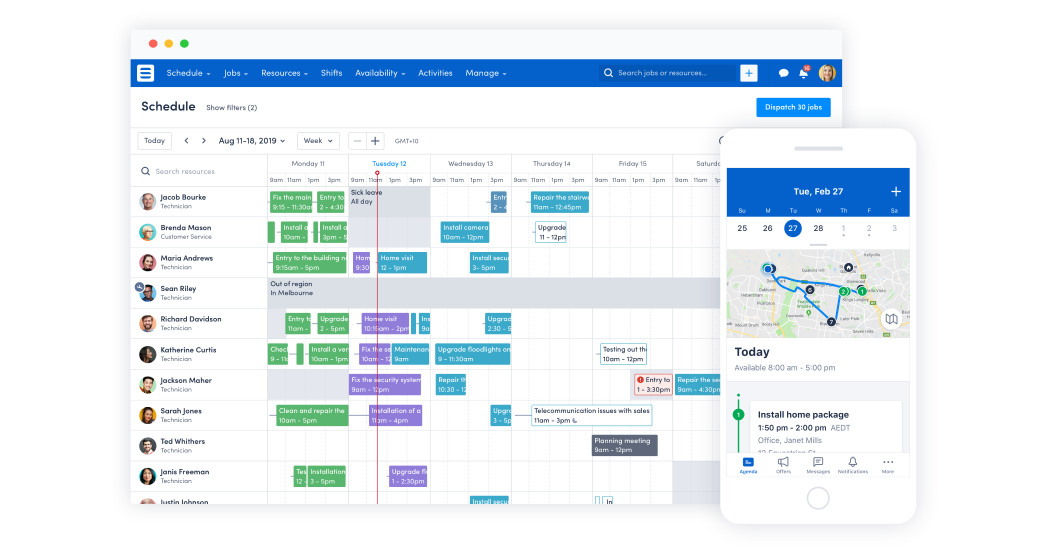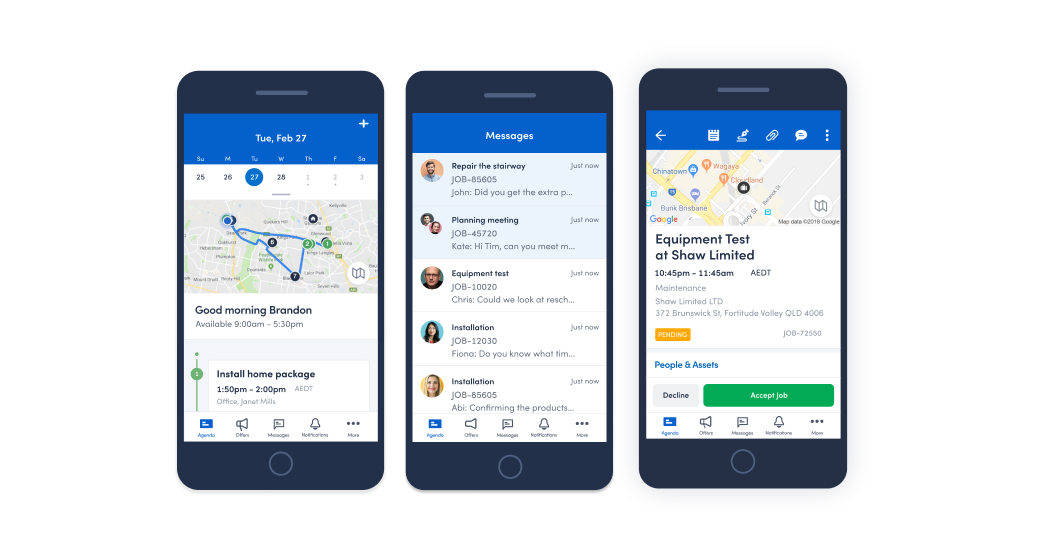Dispatch Schedule Software: 5 Ways to Drive Productivity and Profitability
For organizations with a deskless workforce, an efficient scheduling and dispatching process is crucial for delivering an exceptional customer (and employee) experience. The business’s success relies, in large part, upon dispatchers and staff schedulers, who must balance customer demand with worker availability; along with numerous other factors.
In order to do so properly, they need access to various ever-changing details, like each field worker’s availability, qualifications, and current location; ideal travel routes; customer needs and preferences; employee job history; up-to-date worker schedules; and real-time job progress. They must then use that information to effectively prioritize each job, route deskless workers, provide updated communications (to employees and clients alike), and ensure each mobile employee has the tools they need to get the job done. Done manually, dispatchers and staff schedulers may struggle to make schedules that effectively respond to constantly shifting variables.
To mitigate these challenges and boost performance, productivity, and profitability, organizations need robust dispatch and schedule software. With the right tool, dispatchers and schedulers can optimize their processes and gain a competitive edge.
Common Dispatch Challenges
Many companies still struggle to implement an effective scheduling and dispatching process, as outdated tools and limited visibility hinder their success. In fact, 52% of field service organizations continue to use manual methods for managing their mobile workforce operations, including the scheduling and dispatching of employees. Without some foundational best practices and powerful tools for support, though, these businesses lack the real-time knowledge that’s required for an efficient scheduling and dispatching process. Limited access to this relevant data creates workflow bottlenecks, increases the chance for error, and prevents consistent, clear communication. These issues ultimately accumulate to hinder workers’ efficiency and productivity and—in turn—the organization’s profitability.
Dispatchers deal with a litany of unique obstacles during any given day. Their success (and the company’s bottom line) depends on the flawless orchestration of myriad tasks, but they’re often impeded by:
High service costs
In their efforts to deliver high quality service, companies amaass significant costs; for labor, travel, inventory, and more. It’s an operational balancing act that, if left unoptimized, can negatively impact profitability as the organization grows. Without the proper dispatching tools to support the process, deskless workers spend more time on the road (and less time serving customers), are improperly matched for jobs (resulting in repeat visits), and don’t have the right equipment to finish the job the first time. These issues diminish worker productivity and make it difficult to provide excellent customer service in a cost-effective manner.
Problems in resource matching
Without the right technology for understanding customer demand versus worker availability, skill sets, and current locations, dispatchers struggle to properly match the right resource to the right job. In periods of decreased demand, this can mean higher turnover rates, as employees aren’t consistently utilized or fulfilled. On the other hand, busy periods become problematic if dispatchers don’t have enough field workers (or field workers with the right qualifications) to assign to the increasing number of jobs. And because it’s difficult to retain staff if they’re either over- or under-utilized, the inability to efficiently dispatch them becomes an expensive, frustrating task.
Limited visibility
There are many factors at play in any field service management operation. Customer expectations, overhead costs, and scheduling, performance, and overall processes can positively or negatively affect business outcomes. Without sophisticated tools that offer full visibility into all of these details, dispatchers can’t make informed, meaningful improvements to the scheduling and dispatching process. Traditional industry benchmarks (e.g. windshield time and worker utilization) are no longer enough to remain competitive. Simply put, limited workforce visibility makes it difficult—if not impossible—for organizations to evaluate and improve the effectiveness of their scheduling and dispatching process. Productivity and efficiency suffer, and the business is left wondering what they need to fix to maintain profitability.
Communication issues
All too often, field service organizations implement a variety of disparate tools in an effort to empower their deskless workers. But in reality, disconnected tools cause issues in communication, productivity, and efficiency, as they require mobile employees to toggle between multiple apps to send and receive updates or access key information. If dispatchers and field workers don’t have seamless, centralized access to a single communication tool, they’re more likely to miss essential job or customer details, incorrectly schedule appointments, arrive late, and waste time searching for critical resources. Customer service suffers, too, if dispatchers and deskless workers don’t have tools to easily access necessary job details in the field or send up-to-date arrival times.
How Modern Technology Solutions Enable Organizational Success
By empowering dispatchers with the right technology, field service organizations can overcome the challenges associated with an inadequate dispatching and scheduling process to boost worker productivity, operational efficiency, and their bottom line. By implementing advanced dispatch and scheduling software, businesses gain a variety of benefits, including:
1. Intelligent, Efficient Scheduling
Modern solutions automate the scheduling process by synthesizing relevant factors (e.g. job scope, timing, worker availability and skills, etc.) to assign the right person to the right job, every time. Dispatchers no longer need to rely on traditional tools—like spreadsheets—with stagnant, outdated information to schedule each appointment.
Instead, they can rapidly and efficiently create accurate schedules that maximize deskless workers’ time. Customers are met with fully prepared, qualified workers who are ready to complete the job correctly the first time around. And because the time-consuming, manual burden of scheduling is lifted, employees are freed up to spend their time on revenue-generating activities, like serving more customers.
2. Route Planning and Optimization
There are many elements that dispatchers must consider when routing field workers from one job to the next, and those elements can change at the drop of a hat. Traffic delays, road closures, weather, unanticipated detention time for fleet vehicles, and constraints for accessing certain job sites can lead to mishaps that ultimately affect customer perception and satisfaction. But with the right software, dispatchers can quickly and seamlessly identify optimal routes based on each potential consideration.
Plus, deskless workers can access those routes on their mobile devices, so they no longer have to switch between routing tools to receive updated directions. That means more time for dispatchers to focus on high-value tasks (like processing and scheduling more calls) and for mobile workers to focus on the road. And when deskless workers always have the most efficient route to each assignment, they spend less time on the road and more time doing what they do best: delivering excellent service to more customers.
3. Resource matching
Prioritizing jobs and assigning them to the right workers is a crucial part of any dispatcher’s workload. To execute this efficiently, they need up-to-date details around deskless workers’ availability, skill sets, and locations, as well as optimal travel routes and relevant job information. For example, matching a mobile worker with an applied behavior analysis (ABA) therapy appointment requires a tool that can handle a great deal of complexity. If the client is a child, speaks another language, or has other preferences, they need a behavioral therapist whose skills and experience match those requirements. Intelligent dispatch and scheduling software takes the guesswork out of the equation by taking into account each of these details. Dispatchers can more easily maximize resource utilization to avoid issues in over- or under-worked deskless employees, premature burnout, and high turnover rates. The result is a workforce that can consistently meet customer demand and expectations, which means greater employee satisfaction and retention and higher profitability.
4. Integrated, mobile-first technology
Modern dispatch scheduling software offers a mobile-first approach for users, with tools that integrate with mobile devices to offer real-time communication between the back-office and deskless employees, streamline operations, and increase worker efficiency. They support the unique needs of dispatchers and field workers alike with a centralized app that goes beyond chat and simple routing to provide employees with everything they need to deliver exceptional customer service. Plus, they offer a well-designed mobile interface to meet the demands of today’s app-conscious workforce; so businesses that deploy these tools can rest assured their employees will actually use them.
Dispatchers can create and adjust schedules on the fly, match the right employee to the right job, and share updates with deskless workers, regardless of where they are. Mobile workers can collect data in the field and automatically sync information back to a central system for deeper insights—which can then be used to further improve both the dispatching and scheduling process and the company’s bottom line.
5. Real-time Communication
Dispatchers and mobile workers must keep track of vital customer details, new or canceled appointments, essential resources, and broader company news; all of which is made easier by leveraging the proper tools. Robust software centralizes all communication in a single place, so dispatchers and deskless workers can always send, receive, and access updates, even from their mobile devices. For example, if a customer cancels an appointment, the dispatcher can immediately share this update with the relevant field worker, who can then avoid wasting the time it would take to show up for a nonexistent job. Workers are always in the know and can operate productively and knowledgeably, ensuring an excellent customer experience every time.
Boost Efficiency and Revenue with Intelligent Dispatching and Scheduling Software
Competitive organizations need powerful tools that optimize the dispatching and scheduling process. To build or maintain a cost-effective, productive, efficient, and profitable field service operation, they must leave outdated, manual methods in the past and empower dispatchers and deskless workers. Getting it right requires a solution that improves workforce visibility, automates scheduling, and matches the right worker to the right job.
Skedulo’s deskless productivity cloud eliminates the challenges associated with dispatching a deskless workforce; with tools that simplify the complex scheduling process, optimize routes, ensure proper resource matching, streamline communication, and more.
Learn more about how the right tools can help you improve your scheduling and dispatching process to master the field service evolution, or book a demo today.





